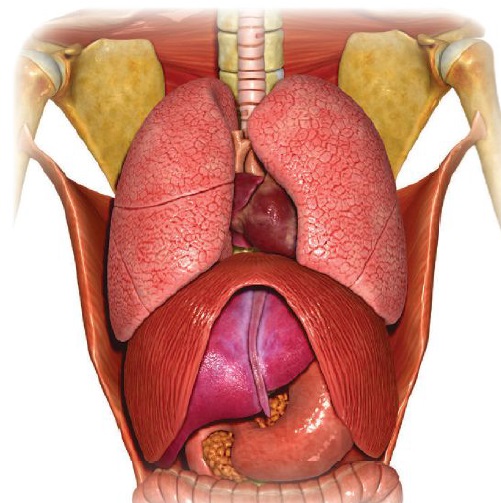Human lubricants
R. David Whitby | TLT Worldwide July 2015
Serous fluids help keep our internal organs functioning smoothly.

The three most important serous membranes are the pericardium, the peritoneum and the pleura.
IN PREVIOUS COLUMNS I HAVE WRITTEN ABOUT LUBRICATION, friction and wear for non-metallic applications, including hair, knee joints and fabric fibers.
In addition to knee joints and hip joints, a very important topic for human lubrication (and for all other vertebrate animals) is serous fluid. Serous (or serosal) fluids are transparent—typically pale yellow—benign bodily lubricants that originate from serous glands.
Serous membranes (or serosa), are two-layered membranes that surround a number of organs in the body. Without these membranes and their serous fluids, we would find it very difficult and painful to breath, circulate blood or digest food. Just as important, the organs that need to move inside us, including our muscles, would likely wear out very quickly.
Serous membranes are smooth, consisting of two layers of epithelial cells, which secrete serous fluid. The inner layer—the visceral membrane—covers organs in body cavities. This inner layer of epithelial cells is followed by a connective tissue, after which is the second layer of epithelial cells, called the parietal membrane.
In humans, the three most important serous membranes are the pericardium, the peritoneum and the pleura.
The pericardium is a double-walled sac containing the heart and the roots of the major blood vessels. The sac has a serous layer and a fibrous layer. It encloses the pericardial cavity, which contains pericardial fluid. The pericardium fixes the heart to the mediastinum, gives protection against infection, protects the heart from any kind of external jerk or shock and provides the lubrication for the heart. The serous pericardium, in turn, is divided into two layers: the parietal pericardium, which is fused to and inseparable from the fibrous pericardium, and the visceral pericardium, which is part of the epicardium. Both of these layers function in lubricating the heart to prevent friction during heart activity.
The peritoneum is the largest serous membrane in the body, a part of which is applied against the internal abdominal wall (parietes), while the remainder surrounds the contained internal organs (viscera). The free surface of the membrane is smooth, covered by a flattened layer of endothelium and lubricated by a small quantity of serous fluid. The internal organs—particularly the stomach, small intestine and large intestine—are therefore able to glide freely against the abdominal wall or each other with the least possible amount of friction. The peritoneum differs from the other serous membranes by being much more complex. It connects the internal organs with the parietal portions, thereby assisting with the support and fixation of the internal organs, while allowing them to move somewhat. The diverse attachments of the peritoneum divide the abdominal cavity into several compartments.
Peritoneal fluid is made in the abdominal cavity to lubricate the surface of the tissue that line the abdominal wall and covers most of the organs in the abdomen. During digestion, the stomach must be able to expand (considerably) and to move while the food is being churned, to help break it down into a pulp. Following this, peristalsis occurs in the small and large intestines, as the food is moved downward while the nutrients are being absorbed into the bloodstream. The peritoneal fluid lubricates all these movements.
The pleural cavity is the potential space between the two pleurae (visceral and parietal) of the lungs. The pleura is a serous membrane that folds back onto itself to form a two-layered structure. The thin space between the two pleural layers is known as the pleural cavity and normally contains a small amount of serous fluid. The outer pleura (parietal pleura) is attached to the chest wall. The inner pleura (visceral pleura) covers the lungs and adjoining structures, via blood vessels, bronchi and nerves.
The pleural membranes and associated fluid serve to protect the lungs and to provide lubrication. Lung tissue is delicate and easily damaged compared to muscle, bone or connective tissue. Protecting the lungs from damaging interactions with other tissues is important. The lungs are also constantly expanding and contracting. The pleural membranes and fluid allow the lungs to easily move within the body cavity with minimal friction from other organs.
Serous fluids are composed of solutions of low molecular weight proteins, usually between 1,000 and 2,000 grams per deciliter, and glucose, usually about 75 milligrams per deciliter, in water. In the average person, there are about 40 milliliters of pericardial fluid, about 8 milliliters of pleural fluid and less than 100 milliliters of peritoneal fluid.
Thank goodness for human lubricants.
 David Whitby is chief executive of Pathmaster Marketing Ltd. in Surrey, England. You can reach him at pathmaster.marketing@yahoo.co.uk
David Whitby is chief executive of Pathmaster Marketing Ltd. in Surrey, England. You can reach him at pathmaster.marketing@yahoo.co.uk.